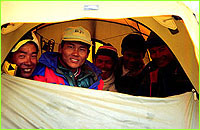
|
 |
 |
 Sherpas on Everest
Sherpas on Everestby Audrey Salkeld and Liesl Clark "You cannot be a good mountaineer, however great your ability, unless you are cheerful and have the spirit of comradeship. Friends are as important as achievement. Another is that teamwork is the one key to success and that selfishness only makes a man small. Still another is that no man, on a mountain or elsewhere, gets more out of anything than he puts into it." —Tenzing NorgaySherpas have an unmatched spirit and positive outlook that has been written about the world over. From the early days of mountaineering, their prowess at high altitude has not gone unnoticed. It is generally believed that the first person to recognize the value of employing Sherpas for expeditionary work was the Aberdeen physiologist, Dr. A.M. Kellas. At the beginning of this century, he taught chemistry at Middlesex Hospital in London, and spent several months every year exploring the more remote passes and valleys of the Himalaya with trusted bands of Sherpas assisting him. General Bruce, too, appreciated the hardiness of Sherpas. For the pioneer Everest expeditions of 1922 and 1924 he engaged his porter force from among the considerable expatriate Sherpa community in Darjeeling. These men performed so well, climbing and carrying to the highest camps, that it very soon became the custom for all Himalayan climbing expeditions to hire Sherpa help in Darjeeling. A system of registration came into force that contributed to the recognition of Sherpa "Tigers" and the creation of an elite force. Word filtered back to the Sherpa Homeland in Nepal, which was out of  bounds to Westerners, and every year more Sherpas would make
their way to Darjeeling to take on this kind of work. Sherpa
Tenzing Norgay, hearing of the continuing British climbing
expeditions to Mount Everest, came to India in 1933, hoping to
be taken on for that year's expedition. He was not among those
selected, but in 1935, at the age of 19, he was picked by Eric
Shipton to take part in the exciting reconnaissance he was
leading to the Everest area. Tenzing stayed on in Darjeeling
and took part in no fewer than seven Everest expeditions,
culminating in his successful first ascent of the mountain
with Edmund Hillary in 1953. By that time, Nepal was opening
up to outsiders, and Sherpas were hired locally and brought
down to Kathmandu.
bounds to Westerners, and every year more Sherpas would make
their way to Darjeeling to take on this kind of work. Sherpa
Tenzing Norgay, hearing of the continuing British climbing
expeditions to Mount Everest, came to India in 1933, hoping to
be taken on for that year's expedition. He was not among those
selected, but in 1935, at the age of 19, he was picked by Eric
Shipton to take part in the exciting reconnaissance he was
leading to the Everest area. Tenzing stayed on in Darjeeling
and took part in no fewer than seven Everest expeditions,
culminating in his successful first ascent of the mountain
with Edmund Hillary in 1953. By that time, Nepal was opening
up to outsiders, and Sherpas were hired locally and brought
down to Kathmandu. The first ascent of Everest, far from marking an end to interest in the accessibility of the highest point on Earth, opened the floodgates to hordes of other climbers, trekkers, and tourists into the Solu Khumbu region, noticeably changing the local economy and lifestyle of the Sherpa people. With the arrival of modern climbing and the desire to conquer the world's highest peaks, theirs became the gateway culture to Everest and other peaks for visitors in search of mountaineering glory. Continue Lost on Everest | High Exposure | Climb | History & Culture | Earth, Wind, & Ice E-mail | Previous Expeditions | Resources | Site Map | Everest Home Editor's Picks | Previous Sites | Join Us/E-mail | TV/Web Schedule About NOVA | Teachers | Site Map | Shop | Jobs | Search | To print PBS Online | NOVA Online | WGBH © | Updated November 2000 |